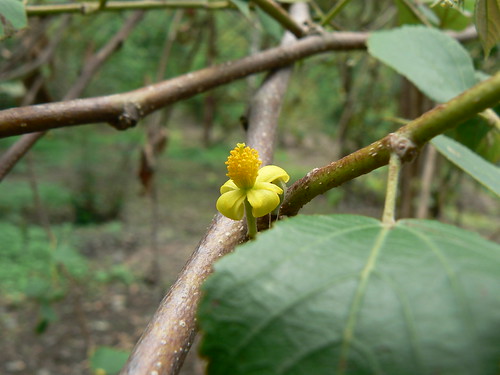Close up of seed of Mirabilis jalapa, Four O'clock, Marvel of Peru...Chụp gần hạt Bông Phấn, Hoa Phấn ...
Image by Vietnam Plants & America plants
Vietnamese named : Hoa Phấn, Bông Phấn, Sâm Ớt
Common names : Four O'clock, Marvel of Peru, Beauty of Night, Broken Colors.
Scientist name : Mirabilis jalapa L.
Synonyms : Nyctago jalapa (Linnaeus) Candolle.
Family : Nyctaginaceae. Họ Bông Phấn
Kingdom:Plantae
(unranked):Angiosperms
(unranked):Eudicots
(unranked):Core eudicots
Order:Caryophyllales
Genus:Mirabilis
Species:M. jalapa
Links :
**** yhoccotruyen.vn/index.php?option=com_content&view=art...
Hoa phấn, Bông phấn, Sâm ớt - Mirabilis jalapa L., thuộc họ Hoa giấy - Nyctaginaceae.
Mô tả: Cây nhỏ cao 20-80cm. Rễ phình thành củ như củ sắn. Thân nhẵn mang nhiều cành, phình lên ở các mấu; cành nhánh dễ gẫy. Lá mọc đối, hình trứng, chóp nhọn. Cụm hoa hình xim có cuống rất ngắn, mọc ở nách lá gần ngọn. Hoa hình phễu, màu hồng, trắng hoặc vàng, rất thơm, nhất là về đêm. Quả hình cầu, khi chín màu đen, mang đài tồn tại ở gốc, bên trong có chất bột trắng mịn.
Bộ phận dùng: Rễ và toàn cây - Radix et Herba Mirabitis.
Nơi sống và thu hái: Cây gốc ở Mehico, được nhập trồng làm cảnh trong các vườn gia đình, cũng trồng ở các vườn thuốc. Trồng bằng hạt, độ 4-5 tháng thì có củ dùng được. Cây không kén chọn đất và nếu có đất xốp ẩm thì có nhiều củ và củ to. Thu hoạch rễ củ quanh năm, rửa sạch, bóc vỏ, thái mỏng dùng tươi hoặc phơi khô dùng dần. Có thể tẩm nước gừng rồi phơi khô, sao vàng để dùng, hoặc tán bột.
Thành phần hóa học: Có alcaloid trigonellin.
Tính vị, tác dụng: Rễ củ Hoa phấn có vị ngọt, nhạt, tính mát, có tác dụng tiêu viêm, lợi tiểu, hoạt huyết tán ứ. Ở Ấn Độ người ta cho rằng rễ kích dục, lọc máu; còn lá làm dịu, giảm niệu.
Công dụng, chỉ định và phối hợp: Thường dùng trị: 1. Viêm amygdal; 2. Viêm nhiễm đường tiết niệu, viêm tiền liệt tuyến; 3. Đái tháo đường, đái ra dưỡng trấp; 4. Bạch đới, băng huyết, kinh nguyệt không đều; 5. Tạng khớp cấp. Dùng ngoài trị viêm vú cấp, đinh nhọt và viêm mủ da, đòn ngã tổn thương, bầm giập, eczema. Hoa dùng trị ho ra máu. Dùng rễ 15-20 g dạng thuốc sắc, hoặc dùng 6-16g bột. Nghiền cây tươi để đắp ngoài, hoặc đun sôi lấy nước rửa. Phụ nữ có thai không dùng.
Đơn thuốc:
1. Viêm amygdal: chiết dịch lá tươi và đắp vào chỗ đau.
2. Ho ra máu. Hoa 120g, chiết dịch và trộn với mật ong uống.
**** vho.vn/search.php?ID=6604&keyword=Ho
**** vi.wikipedia.org/wiki/B%C3%B4ng_ph%E1%BA%A5n
_____________________________________________________________
**** en.wikipedia.org/wiki/Mirabilis_jalapa
Mirabilis jalapa (The four o'clock flower or marvel of Peru) is the most commonly grown ornamental species of Mirabilis, and is available in a range of colours. Mirabilis in Latin means wonderful and Jalapa is a town in Mexico. Mirabilis jalapa is said to have been exported from the Peruvian Andes in 1540.
Flowers and color
A curious aspect of this plant is that flowers of different colors can be found simultaneously on the same plant.
Variegated flower on a four o'clock plant.
Naturally occurring color variation on four o'clock flowers.
Additionally, an individual flower can be splashed with different colors. Another interesting point is a color-changing phenomenon. For example, in the yellow variety, as the plant matures, it can display flowers that gradually change to a dark pink color. Similarly white flowers can change to light violet.
A four o'clock plant in full bloom.
The flowers usually open from late afternoon onwards, then producing a strong, sweet-smelling fragrance, hence the first of its common names. In Southern India, it is called as "Anthi Mandhaarai" (Tamil: அந்தி மந்தாரை).In AndhraPradesh it is called as "Chandrakantha"(Telugu: చ౦దరకా౦త). In Kerala it is called as 'Naalu mani poovu'. In Maharashtra, it is called "Gulabakshi" (Marathi: गुलबक्षी). In Assamese it is called 'Godhuli Gopal', 'godhuli' meaning evening. In China, it is called the "shower flower" (Chinese: 洗澡花; pinyin: xǐzǎo huā) or "rice boiling flower" (simplified Chinese: 煮饭花; traditional Chinese: 煮飯花; pinyin: zhǔfàn huā) because it is in bloom at the time of these activities. In Hong Kong, it is known as "purple jasmine" (紫茉莉). Despite their appearance, the flowers are not formed from petals – rather they are a pigmented modification of the calyx.
The flowers are pollinated by long-tongued moths of the Sphingidae family, such as the sphinx moths or hawk moths and other nocturnal pollinators attracted by the fragrance
Habitat and cultivation
M. jalapa hails from tropical South America, but has become naturalised throughout tropical and warm temperate regions. In cooler temperate regions, it will die back with the first frosts, regrowing in the following spring from the tuberous roots. The plant does best in full sun. It grows to approximately 0.9 m in height. The single-seeded fruits are spherical, wrinkled and black upon maturity (see picture), having started out greenish-yellow. The plant will self-seed, often spreading rapidly if left unchecked in a garden. Some gardeners recommend that the seeds should be soaked before planting, but this is not totally necessary. In North America, the plant perennializes in warm, coastal environments, particularly in USDA Zones 9–10.
Genetic studies
Around 1900, Carl Correns used the four o'clock as a model organism for his studies on cytoplasmic inheritance. He used the plant's variegated leaves to prove that certain factors outside the nucleus affected phenotype in a way not explained by Mendel's theories.[2] Correns proposed that leaf color in Mirabilis was passed on via a uniparental mode of inheritance.[2]
Also, when red-flowered plants are crossed with white-flowered plants, pink-flowered offspring, not red, are produced. This is an exception to Mendel's Law of Dominance, because in this case the red and white genes are of equal strength, so neither can dominate the other.
Uses
The flowers are used in food colouring. The leaves may be eaten cooked as well, but only as an emergency food.[3]
An edible crimson dye is obtained from the flowers to colour cakes and jellies.[3]
In herbal medicine, parts of the plant may be used as a diuretic, purgative, and for vulnerary (wound healing) purposes. The root is believed an aphrodisiac as well as diuretic and purgative. It is used in the treatment of dropsy.
The leaves are used to reduce inflammation. A decoction of them (mashing and boiling) is used to treat abscesses. Leaf juice may be used to treat wounds.
Powdered, the seed of some varieities is used as a cosmetic and a dye.[3] The seeds are considered poisonous
**** www.efloras.org/florataxon.aspx?flora_id=610&taxon_id...
This species is used medicinally and as an ornamental.
Originally introduced as an ornamental, now a ruderal weed in some areas of China [native to tropical America; now pantropical].
**** www.treknature.com/gallery/photo170042.htm
**** www.floridata.com/ref/m/mira_jal.cfm
**** toptropicals.com/catalog/uid/MIRABILIS_JALAPA.htm
day thirty eight--looks more painful than it actually is
Image by ohmyGaly
blaaghh ok so today started off as a shitty shitty day. I mean, i was down with the Obama inauguration (GOBAMA!!), but class after that just sucked. but after that first class, I went to grab a coffee and a muffin then went to my second class which was much MUCH better.
For my last "class" I hung out with my bff Lizzy (lacompean, wooster, lovie, PYT). We had such a great talk and I got to vent and just tell her a whole bunch of stuff that has been bothering me. Then she told me all about her amazingness and how life has been fabulous for her and lifted my spirits.
We even went on a photo treasure hunt. We went around taking pictures....until my battery died...whoops. I hate when I do that...my bad.. But it was a really great afternoon to a shitty morning. I even took a nap and I'm now going to be working on homework...after I post some of those really cutsie pictures :)
just a quick little break from my domestic/kitcheny type theme.
ohoh and I JUST found out that I've been accepted to University of Portland WOOHOO!!
038/365
Bariuan-gulod
Image by dinesh_valke
Tiliaceae (phalsa family) » Grewia asiatica
... inflorescence in 3-5 flowered axillary cymes, clustered in groups of 2-8, 16-25 cm long. (This picture shows solitary flower in axil - does it mean this specimen is some different species?)
Receptacle 3 mm long, hairy in the upper half. Sepals 5, oblong, 1-5 cm, almost glabrous inside, 3-5-nerved. Petals 5, yellow, 6-7 mm long, equalling the androecium, with a raised gland 2 mm long, glabrous, with reticulate nervation.
Note: Identification or description may not be accurate; it is subject to your review.
Tidak ada komentar:
Posting Komentar